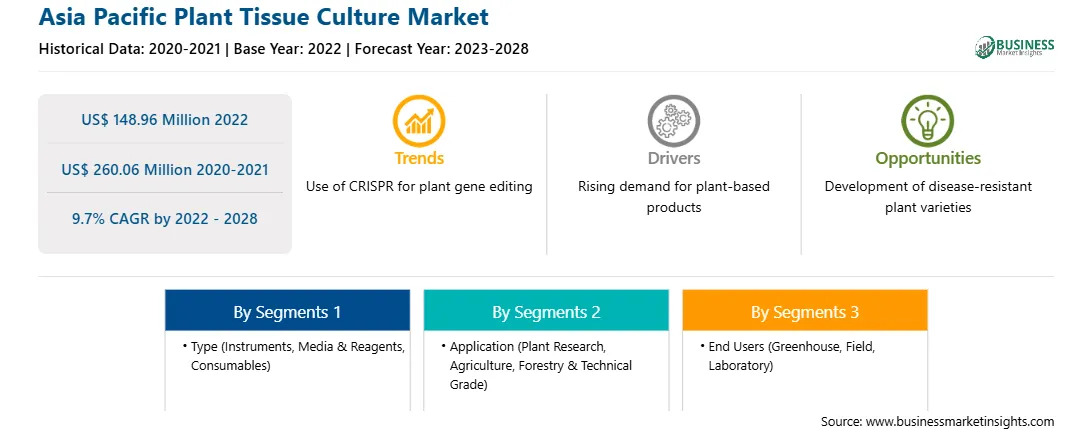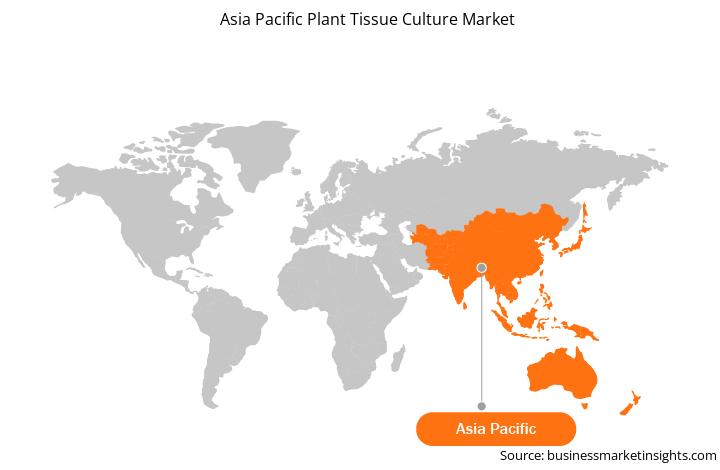亚太地区植物组织培养市场预测至 2028 年 – COVID-19 影响和区域分析 – 按类型(仪器、培养基和试剂以及消耗品)、应用(植物研究、农业、林业和技术级等)和最终用户(温室、田间和实验室)
No. of Pages: 134 | Report Code: BMIRE00027906 | Category: Life Sciences
No. of Pages: 134 | Report Code: BMIRE00027906 | Category: Life Sciences
工厂改进举措发展中国家的培养实践促进亚太地区植物培养
未来几年组织培养市场的增长
植物组织培养在亚太地区越来越受欢迎,因为它可以用来生产和种植数千种植物品种。在泰国,组织培养用于繁殖生长缓慢且对环境敏感的兰花。泰国是东南亚组织培养领域的领先国家之一,每年生产 5000 万株苗。其中大部分是兰花,这帮助该国成为亚太地区最大的整株兰花和切花兰花出口国。此外,已经开发了芽培养技术的微繁殖用于香蕉的大规模繁殖。在菲律宾,微繁殖被用作控制香蕉病毒性疾病传播的方法,例如香蕉束顶病毒(BBTV)和香蕉苞花叶病毒(BBrMV),这些病毒通常通过繁殖材料传播。各个发展中国家正在采取举措,投资植物组织培养并资助研究项目,以便能够将其产品出口到新市场。 2022年,商务部和商务部印度工业界向出口商提供帮助,鼓励他们通过进入新市场来促进组织培养植物的出口。印度正在开展各种涉及组织培养的项目,这些项目由生物技术部 (DBT) 资助。例如,DBT资助了一个名为“与大辣椒(Capsicum chinense)相关微生物的化学分析,特别涉及东北地区的生长促进、生物控制和类辣椒素生产”的组织培养项目。是由 DBT 资助的。各国政府和政府资助机构为促进组织培养所做的努力正在为亚太地区植物组织培养市场的增长创造机会。
亚太地区植物组织培养市场概况
亚太地区预计将注册预测期内全球植物组织培养市场复合年增长率最快。中国、印度和东南亚是该地区市场增长的主要贡献者。 2021 年,亚太地区约占全球市场的 xx% 份额。该地区的市场增长归因于政府对植物组织培养的大力支持以及对基于组织培养的研究的投资增加,以及农业领域先进技术的采用。印度、中国、印度尼西亚、菲律宾、越南、泰国等都是农业经济体。因此,该地区植物组织培养生产公司的消费者基础正在大幅增长。
亚太地区植物组织培养市场细分
亚太地区植物组织培养市场根据类型、应用、最终用户和
根据类型,亚太地区植物组织培养市场分为仪器、培养基和设备。试剂和耗材。仪器细分市场在2022年占据最大的市场份额。此外,仪器细分市场分为培养箱、离心机、显微镜、灭菌器等。同样,媒体和试剂分为murashige和skoog介质、linsmaier和skoog介质等。
根据应用,亚太植物组织培养市场细分为植物研究、农业、林业和农业。技术等级等。 农业细分市场在 2022 年占据最大市场份额。
根据最终用户,亚太工厂组织培养市场分为温室、田间和实验室。 田间细分市场在 2022 年占据最大的市场份额。
按国家/地区划分,亚太地区植物组织文化市场分为中国、印度、日本、韩国、澳大利亚和亚太其他地区。 2022 年,中国将主导市场。
Thomas Scientific LLC;西格玛-奥德里奇有限责任公司; HiMedia 实验室私人有限公司;沉箱实验室公司;阿尔法实验室有限公司;贝克顿·迪金森公司;和 AI Wathba Marionnet LLC。是亚太地区植物组织培养市场的领先公司。
Strategic insights for Asia Pacific Plant Tissue Culture involve closely monitoring industry trends, consumer behaviours, and competitor actions to identify opportunities for growth. By leveraging data analytics, businesses can anticipate market shifts and make informed decisions that align with evolving customer needs. Understanding these dynamics helps companies adjust their strategies proactively, enhance customer engagement, and strengthen their competitive edge. Building strong relationships with stakeholders and staying agile in response to changes ensures long-term success in any market.

| Report Attribute | Details |
|---|---|
| Market size in 2022 | US$ 148.96 Million |
| Market Size by 2028 | US$ 260.06 Million |
| Global CAGR (2022 - 2028) | 9.7% |
| Historical Data | 2020-2021 |
| Forecast period | 2023-2028 |
| Segments Covered |
By 类型
|
| Regions and Countries Covered | 亚太地区
|
| Market leaders and key company profiles |
The regional scope of Asia Pacific Plant Tissue Culture refers to the geographical area in which a business operates and competes. Understanding regional nuances, such as local consumer preferences, economic conditions, and regulatory environments, is crucial for tailoring strategies to specific markets. Businesses can expand their reach by identifying underserved regions or adapting their offerings to meet regional demands. A clear regional focus allows for more effective resource allocation, targeted marketing, and better positioning against local competitors, ultimately driving growth in those specific areas.

The Asia Pacific Plant Tissue Culture Market is valued at US$ 148.96 Million in 2022, it is projected to reach US$ 260.06 Million by 2028.
As per our report Asia Pacific Plant Tissue Culture Market, the market size is valued at US$ 148.96 Million in 2022, projecting it to reach US$ 260.06 Million by 2028. This translates to a CAGR of approximately 9.7% during the forecast period.
The Asia Pacific Plant Tissue Culture Market report typically cover these key segments-
The historic period, base year, and forecast period can vary slightly depending on the specific market research report. However, for the Asia Pacific Plant Tissue Culture Market report:
The Asia Pacific Plant Tissue Culture Market is populated by several key players, each contributing to its growth and innovation. Some of the major players include:
The Asia Pacific Plant Tissue Culture Market report is valuable for diverse stakeholders, including:
Essentially, anyone involved in or considering involvement in the Asia Pacific Plant Tissue Culture Market value chain can benefit from the information contained in a comprehensive market report.